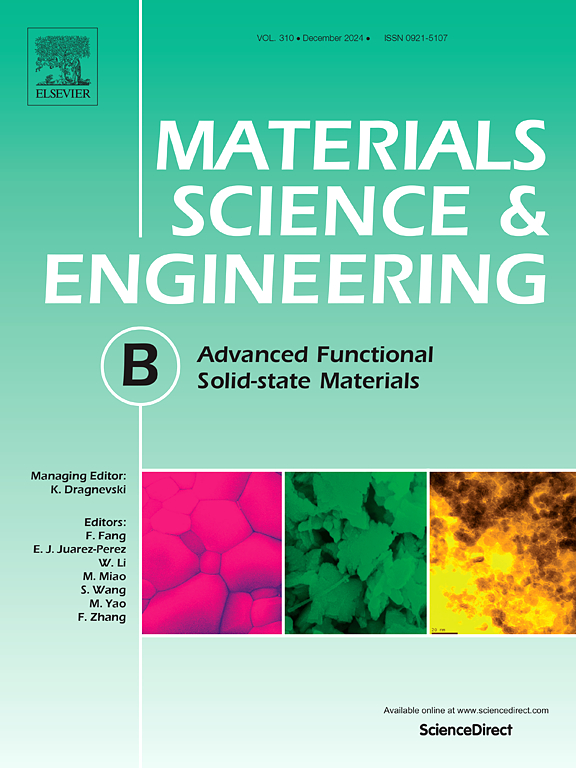应用碳基 MOF 衍生的 Fe/C 复合材料实现优异的微波吸收性能
IF 3.9
3区 材料科学
Q2 MATERIALS SCIENCE, MULTIDISCIPLINARY
引用次数: 0
摘要
随着电磁污染问题的日益严重,制备吸收频带宽、吸收能力强、重量轻、宽度薄的电磁波(EMW)吸收材料已成为当务之急。磁性和碳基复合材料作为电磁波吸收材料已引起广泛关注。金属有机框架(MOFs)衍生物因其量身定制的结构、高比表面积和多孔性而成为新型电磁波吸收材料。然而,如何精确控制碳基 MOF 衍生物以调节介电常数是一项挑战。本文通过室温静置和碳化策略制备了具有规则形状的碳基 MOF 衍生物。通过调整有机三酸与四水氯化亚铁的摩尔比,调节了碳基 MOF 衍生物的微观结构和电磁参数。Fe/C-2具有最小反射损耗(RLmin)-40.42 dB,匹配厚度为4 mm,这主要归功于磁损耗、介质损耗和适当阻抗匹配的互补效应。此外,还利用雷达截面(RCS)模拟评估了吸收器的实际应用,结果表明 Fe/C-2 的 RCS 降低值最大。本研究提出的碳基 MOF 衍生物吸波材料可为优化电磁吸波材料提供有价值的见解。本文章由计算机程序翻译,如有差异,请以英文原文为准。
Application of carbon-based MOF derived Fe/C composites toward excellent microwave absorption
According to the escalating issue of electromagnetic pollution the preparation of electromagnetic wave (EMW) absorbing materials with wide absorption band, strong absorption capacity, light weight and thin width is currently pursued. The combination of magnetic and carbon-based composites as EMW-absorbing materials has attracted a wide attention. Metal-organic frameworks (MOFs) derivatives have become new EMW absorbing materials due to the tailored structure, high specific surface area and porosity. However, precisely controlling the carbon-based MOF derivatives to regulate permittivity poses a challenge. In this paper, carbon-based MOF derivatives with regular shape were prepared by room temperature standing and carbonization strategies. The microstructure and electromagnetic parameters of carbon-based MOF derivatives were regulated by adjusting the molar ratio of the organic trimesic acid to the ferrous chloride tetrahydrate. The Fe/C-2 possess minimum reflection loss (RLmin) −40.42 dB, matching thickness 4 mm, which is mainly due to the complementary effects of magnetic loss, dielectric loss, and suitable impedance matching. Moreover, the practical application of the absorbers was evaluated using radar cross-section (RCS) simulation, indicating the maximum RCS reduction value of Fe/C-2. The carbon-based MOF derivative absorber presented in this work can offer valuable insights for optimizing electromagnetic absorbers.
求助全文
通过发布文献求助,成功后即可免费获取论文全文。
去求助
来源期刊

Materials Science and Engineering: B
工程技术-材料科学:综合
CiteScore
5.60
自引率
2.80%
发文量
481
审稿时长
3.5 months
期刊介绍:
The journal provides an international medium for the publication of theoretical and experimental studies and reviews related to the electronic, electrochemical, ionic, magnetic, optical, and biosensing properties of solid state materials in bulk, thin film and particulate forms. Papers dealing with synthesis, processing, characterization, structure, physical properties and computational aspects of nano-crystalline, crystalline, amorphous and glassy forms of ceramics, semiconductors, layered insertion compounds, low-dimensional compounds and systems, fast-ion conductors, polymers and dielectrics are viewed as suitable for publication. Articles focused on nano-structured aspects of these advanced solid-state materials will also be considered suitable.
 求助内容:
求助内容: 应助结果提醒方式:
应助结果提醒方式:


